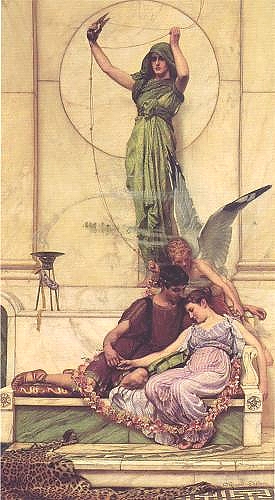 |
Roman CourtshipSir William Ernest Reynolds-Stephens Artist: British sculptor, decorative artist and painter. Born of British parents. He was educated in Germany and England and then at the Royal Academy schools in London from 1884 to 1887, winning prizes in painting and sculpture. Subject: They controlled the metaphorical thread of life of every mortal and immortal from birth to death. Even the gods feared the Parcae. Jupiter also was subject to their power. The names of the three Parcae were: |
- Nona (Greek equivalent Clotho), also known as the Spinner. She is the youngest of the aspects of fate and it is she who spins the thread of human life out of some indescribable material taken from the Void. It was said only she can travel into the Void to obtain this material of life.
- Decima (Greek Lachesis), also known as the Apportioner. She is a middle-aged aspect, who determines the lengths of the threads of life and weaves these threads into a pattern, which controls the events of human life. Decima controls the interaction of humans with each other, all depending upon how she weaves her tapestry.
- Morta (Greek Atropos), who is an elderly woman. She is the fate who cuts the thread or web of life. She is known as the "Inflexible" or "Inevitable", cutting the threads with the "abhorred shears”, ending a mortal’s existence and choosing the manner of death. Some said that she could overrule Decima's life length and "cut a life short".
Many mortals prayed to the Fates in hopes of getting on their good side and not having their life ended and to ensure a good harvest, marriage or child birth.
Painting:
A young couple rest on a bench. She has put her head on his shoulder and he has taken her hand. They have made an (incense) offering to the Gods to ask for their blessing of this romance.
We see Morta holding the threads of their life in her hands. The beads holding together the threads are Decima’s incremental measurements of their life span
It seems that Morta does not approve of this relationship and she rejects the offering (the smoke does not go up, but sideways). Maybe she is jealous? Look at the color of her dress. Is she "green with envy"?
With a scowl on her face, she is going to cut a life short with her abhorred shears.
Whose? The boy or girl?
Cupid, who lovingly drapes a flower garland around the couple (the garland is an extension of the life threads), knows that even he and the other gods cannot stop Morta's inevetable action, so he gently drapes and arranges the garland.
However, the flowers are "Gentleman's Melancholy", thus telling us whose life will be cut short (the girl), and the resulting sorrow and melancholy of the young man.
Historical Context:
We can clearly see the influence of the Pre-Raphaelites. This painting style was still very popular at the turn of the century.
The common name of the flowers ("Gentleman's Melancholy") would also be known by anybody, who saw the painting, since most people had that (showy and easy to grow) plant in their gardens.
Expressions possibly coming from Morta's power:
- A life cut short
- A life hanging by a thread (also the sword of Damocles)
- The fabric of a person's life
- email me more please: send to willem@ringlingdocents.org
Willem van Osnabrugge
October 27, 2011